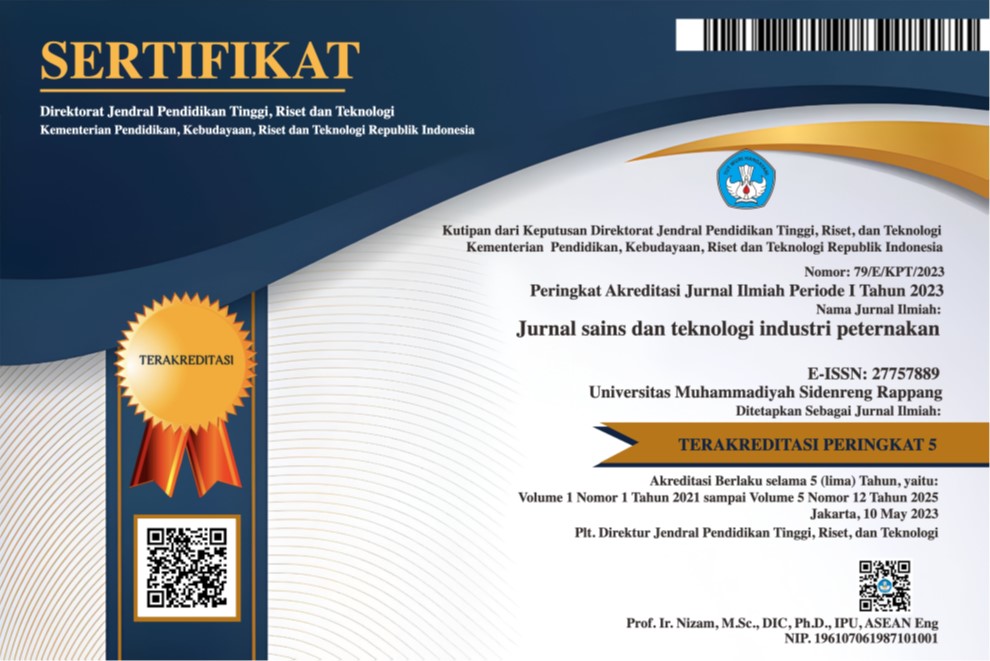PEMBERIAN PUPUK KANDANG YANG BERBEDA TERHADAP PERTUMBUHAN RUMPUT GAJAH MINI (Pennisteum purpureum CV. Mott)
Abstract
The purpose of this study was to determine the application of different manure to the growth of Mini Elephant Grass. This study used the Randomized Block Design (RAK) method with 4 treatments and repeated 4 times so that 16 experimental units were obtained. The treatments of this study were P0: without application of manure, P1: cow manure 910 tons/ha), P2: goat manure 915 tons/ha), P3: chicken manure (20 tons/ha). The parameters measured in this study were plant height, leaf length, number of shoots and fresh weight of Mini Elephant Grass. The results showed that the application of different manure significantly differed (P <0.05) on the number of shoots and fresh weight of Mini Elephant Grass. While for plant height and leaf length showed no difference (P> 0.05). The application of different manure can increase the growth of Mini Elephant Grass consisting of plant height, leaf length, number of shoots and fresh weight. The application of chicken manure (P3) is the best treatment to increase the growth of Mini Elephant Grass.
References
Hasri Ainun, Sudirman, Edi Wahyu Satri, Asrul Hamdani, C. B. (2021). Analisis Produksi Rumput Gajah Mini (Pennisetum purpureum cv. Mott) dengan Jarak Tanam yang Berbeda. Indonesian Journal of Applied Science and Technology Vol., 2(1), 15–24.
Hery Christanto, I. G. A. mas S. A. (2014). Jumlah Bibit Per Lubang dan Jarak Tanam Berpengaruh Terhadap Hasil Padi Gogo (Oryza Sativa L.) Dengan System Of Rice Intensification (Sri) Di Lahan Kering. Jurnal Bumi Lestari, 14(1), 1–8.
Lohe, A., Irwan, M., & Armayani, M. (2024). Evaluasi Pertumbuhan Rumput Gajah Mini (Pennisetum purpureum Cv. Mott) Yang Diintervensi Pupuk Kandang Berbahan Baku feses Sapi Pada level Berbeda. Jurnal Peternakan Lokal, 6(1), 35-43.
Nasahi, C. (2010). Peran Mikroba Dalam Pertanian Organik. Fakultas Pertanian. Universitas Padjadjaran. Bandung.
Rahmawan, R., & Baskara, M. (2024). Pengaruh Pupuk Organik Terhadap Pertumbuhan Rumput Bermuda (Cynodon dactylon var. tifway) Dan Rumput Gajahan (Axonopus compressus). Produksi Tanaman, 12(05), 351–365. https://doi.org/10.21776/ub.protan.2024.012.05.08
Ramadhan Fahri, K. S. (2024). Optimalisasi Pertumbuhan Rumput Gajah (Pennisetum purpureum) melalui Penambahan Pupuk Kandang Di Kecamatan Sawit Seberang, Kabupaten Langkat. Journal of Innovation Research and Knowledge, 4(3), 1509–1518. https://www.bajangjournal.com/index.php/JIRK/article/download/8286/6478/16385.
Salsabila, S., & Islami, T. (2023). Pengaruh Dosis Pupuk Kandang Kambing dan Konsentrasi Gandasil Buah B Terhadap Pertumbuhan Dan Hasil Tanaman Buncis (Phaseolus vulgaris L.) Tipe Tegak Varietas Balitsa 2. Jurnal Produksi Tanaman, 11(9), 660-671. http://dx.doi.org/10.21776/ub.protan.2023.011.09.01
Saripuddin, A., Nopriani, U., & Loliwu, Y.A. (2018). Pertumbuhan dan Produksi Rumput Gajah Mini (Pennisetum purpureum Cv. Mott) deangan Penggunaan Dosis Pupuk Kompos Yang Berbeda. Jurnal Agrovet, 15(1), 26-32.
Sirait, J. (2017). Rumput Gajah Mini (Pennisetum purpureum Cv. Mott) Sebagai Hijauan Pakan Ruminansia. Wartazola, 27(4), 167-176. http://dx.doi.org/10.14334/wartazoa.v27i4.1569
















